The Enigmatic World of Hydrangeas: Beyond the Blooms

Hydrangeas, those captivating floral wonders, have long enchanted gardeners and flower enthusiasts alike. With their large, showy blooms and a wide range of colors, they add a touch of elegance and charm to any garden. However, there is much more to these beautiful shrubs than meets the eye. In this article, we will delve into the symbolism behind hydrangeas, uncover some little - known facts, and explore why you should never take a bite out of their colorful blooms.
### Symbolism of Hydrangeas
Hydrangeas carry a rich tapestry of symbolism that varies across different cultures. In Japan, hydrangeas are deeply connected to gratitude and apology. Legend has it that a Japanese emperor once gave hydrangeas to the family of the girl he loved as a way to express his apology and gratitude. Since then, these flowers have become a symbol of sincere regret and appreciation. On the other hand, in Victorian England, hydrangeas were associated with boastfulness and vanity. This was due to their large, abundant blooms, which were seen as a display of opulence and excess.
In Western cultures today, hydrangeas are often given as a sign of heartfelt emotion. They can represent deep understanding, grace, and beauty. A bouquet of hydrangeas can be the perfect gift for someone you care about, whether it's to celebrate a special occasion or to show your support during a difficult time.
### Little - Known Facts about Hydrangeas
One of the most fascinating aspects of hydrangeas is their ability to change color. The color of hydrangea blooms is not solely determined by genetics but is also influenced by the pH level of the soil. In acidic soil (pH below 6), hydrangeas tend to produce blue or purple flowers. This is because the acidic environment allows the plant to absorb aluminum, which is responsible for the blue color. In alkaline soil (pH above 7), the flowers turn pink or red as the plant is unable to take up aluminum. By adjusting the soil pH, gardeners can manipulate the color of their hydrangea blooms.
Another interesting fact is that hydrangeas have a long history of use in traditional medicine. In some cultures, parts of the hydrangea plant were used to treat various ailments, including kidney stones and urinary tract infections. However, it's important to note that the use of hydrangeas for medicinal purposes should be done under the guidance of a qualified healthcare professional, as improper use can lead to adverse effects.
Hydrangeas are also known for their long - lasting blooms. When cut and placed in a vase, they can stay fresh for up to two weeks with proper care. To ensure a long vase life, it's recommended to cut the stems at an angle, remove any leaves that will be submerged in water, and change the water every few days.
### Why You Should Never Eat Hydrangeas
While hydrangeas are beautiful to look at, they are highly toxic if ingested. All parts of the hydrangea plant, including the flowers, leaves, and stems, contain cyanogenic glycosides. When these compounds are broken down in the body, they release cyanide, which can be extremely harmful. Symptoms of hydrangea poisoning include nausea, vomiting, diarrhea, abdominal pain, and in severe cases, difficulty breathing and even coma.
Children and pets are particularly at risk of hydrangea poisoning as they may be more likely to explore and put things in their mouths. If you suspect that someone has ingested hydrangeas, it's crucial to seek medical attention immediately. Do not induce vomiting unless instructed to do so by a medical professional.
### Growing Hydrangeas
If you're interested in growing hydrangeas in your garden, there are a few things to keep in mind. Hydrangeas prefer partial shade, especially in hot climates. They need well - drained soil that is rich in organic matter. When planting hydrangeas, make sure to dig a hole that is twice as wide as the root ball and just as deep. Water the plant thoroughly after planting and keep the soil consistently moist but not waterlogged.
Fertilizing hydrangeas can also help them thrive. Use a balanced fertilizer in the spring and early summer to promote healthy growth and abundant blooms. Pruning is another important aspect of hydrangea care. Different types of hydrangeas have different pruning requirements, so it's essential to know which type you have before you start pruning.
In conclusion, hydrangeas are a remarkable addition to any garden. Their symbolism, unique characteristics, and beautiful blooms make them a favorite among gardeners. However, it's important to handle them with care, especially when it comes to ingestion. By understanding the many aspects of hydrangeas, you can enjoy these stunning shrubs to the fullest while keeping yourself and your loved ones safe.